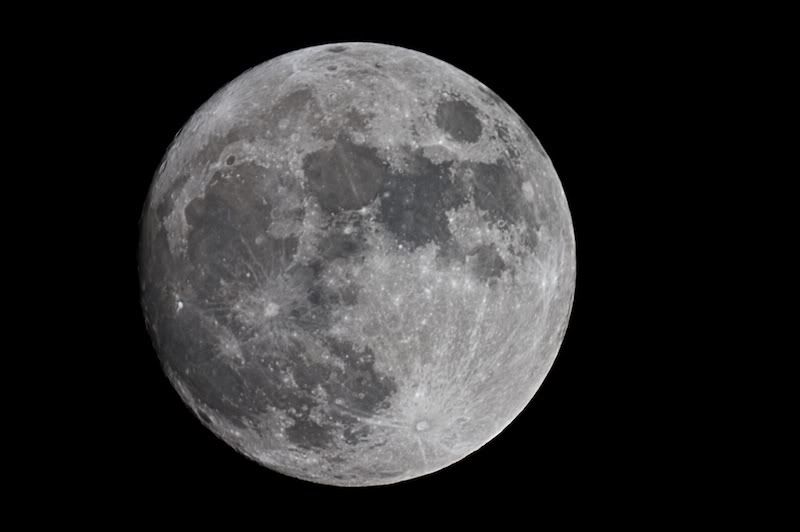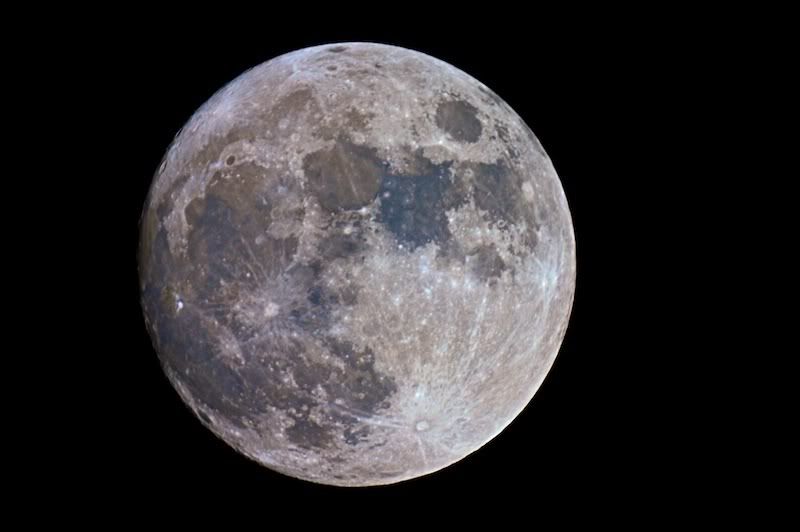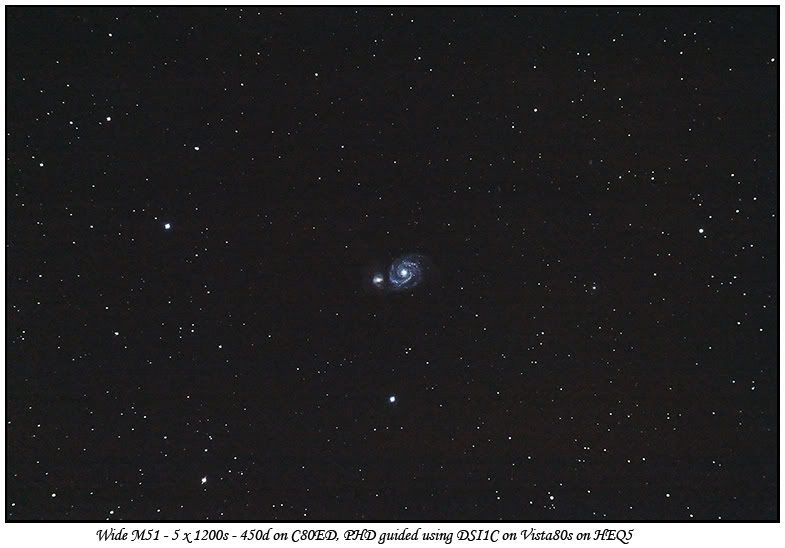I managed to get a shot of the nearly full moon, I can't believe I didn't post these. They aren't the best, it's tricky with no contrast to focus on. It also turns out that my little skymax has some collimation issues I need to sort out but I'll come to that in a mo.
and some colour
About a week later, and more clear skies. I decided to have a go at M51 using the Skymax. During focusing of the 450d, at the 10x magnification I noticed that the out of focus ring patterns were not circular, so this means the collimation is out. I setup in the normal way and, using the 450d, started capturing data. For some reason, and I think it's down to a combination of things, trailing being the biggest, the 2 minute subs won't stack, but here's a single image frame
Anyway, after nearly another week, some more clear skies, and this time, feeling brave, I decided to try out guiding. A little while back, I bought a USBTTL cable from FTDI and fitted the end of a Cat 5 LAN cable to it. I'd tested this with EQMOD for mount control, and was able to control the movement of the scope with it.
I setup the lappy with all the cables plugged in, attempted to focus my Konus guidescope as best as I could, using PHD and the DSI1C, aligned the scopes on Regulus (it's good and bright), set PHD to guiding. The first attempt failed as there wasn't enough motion from PHD. I remembered a mention in a lecture given by Nik Szymanek about this, and found the right setting. It was too low for the little 400mm Konus, so I increased it and tried again. This time it worked perfectly, and within a few minutes PHD told me it was guiding. I set the 450d to capture a single 10 minute sub and waited.
Some time later.. (well only 10 minutes, but it felt like an age...) the camera stopped and I went to check. All the stars were spot on, no problems at all.
I swung the scope around to the M51 area (I'm not using the slewing motors as yet, it'll go through my limited power supply in too short a time, that's for mains power). Took a test shot, tweaked the aim until I was happy, setup for guiding again, although there aren't any bright stars around there, and it took a little tweaking to get it running. Set the camera to 20 minutes, I wanted to see what was possible, and set it off. After only a few minutes, PHD was complaining that the guidestar had been lost. Damn. Clicked stop and guide again, hoping that it hadn't been for too long a period and left it. Well this carried on, and after the third attempted sub, I had a more thorough look at things. I found that the Meade software contains a focus enhancement tool, and I used this to tweak the focus. I'd just for it to as high a value as possible when the mount ran out of power. Ah well, a bunch of wasted subs, but some useful knowledge gained.
Then tonight, only one night later, and again it's clear. This time, armed with my knew knowledge, and already tweaked focus (although I did check it as I'd moved the mount and scopes in) I set out to try again. This time, despite the skies looking somewhat damp, I had no problems locking a guidestar and keeping it locked. I set the camera off for 20 minutes again, and let it run.
After some time, the mount power was running out, I'd only caught 5 frames, and I'd been hoping for 6 (ah well) and all 5 were showing as spot on. I also spotted that the screen on PHD was looking odd. As I was done anyway, I stopped PHD and had a look at the objectives. The Konus was heavily dewed up, the C80ED much less so. I can only conclude that this is the difference in the dew shields. I guess the next purchase is going to be dew control, hmmm, I'll need more power for that too...
I grabbed some darks and flats... The darks are going to be scaled, there's no way I'm waiting an hour to get 3 darks.
After stacking and processing, this is the end result.
I had to do some heavy duty noise reduction, but as I only got 5 subs .. I'm happy and looking forward to being able to grab a bunch of 10 minutes at ISO 800 to add to this.
Sunday, 19 April 2009
Full Moon and getting going with guiding
Subscribe to:
Post Comments (Atom)







2 comments:
Hi there, fantastic images, and really good instruction. Following you closely, regards @craiggold
Good article John - You've got Guiding nailed first time - lucky bugger! There is no going back now my friend - Welcome to the Dark Side :)
Post a Comment